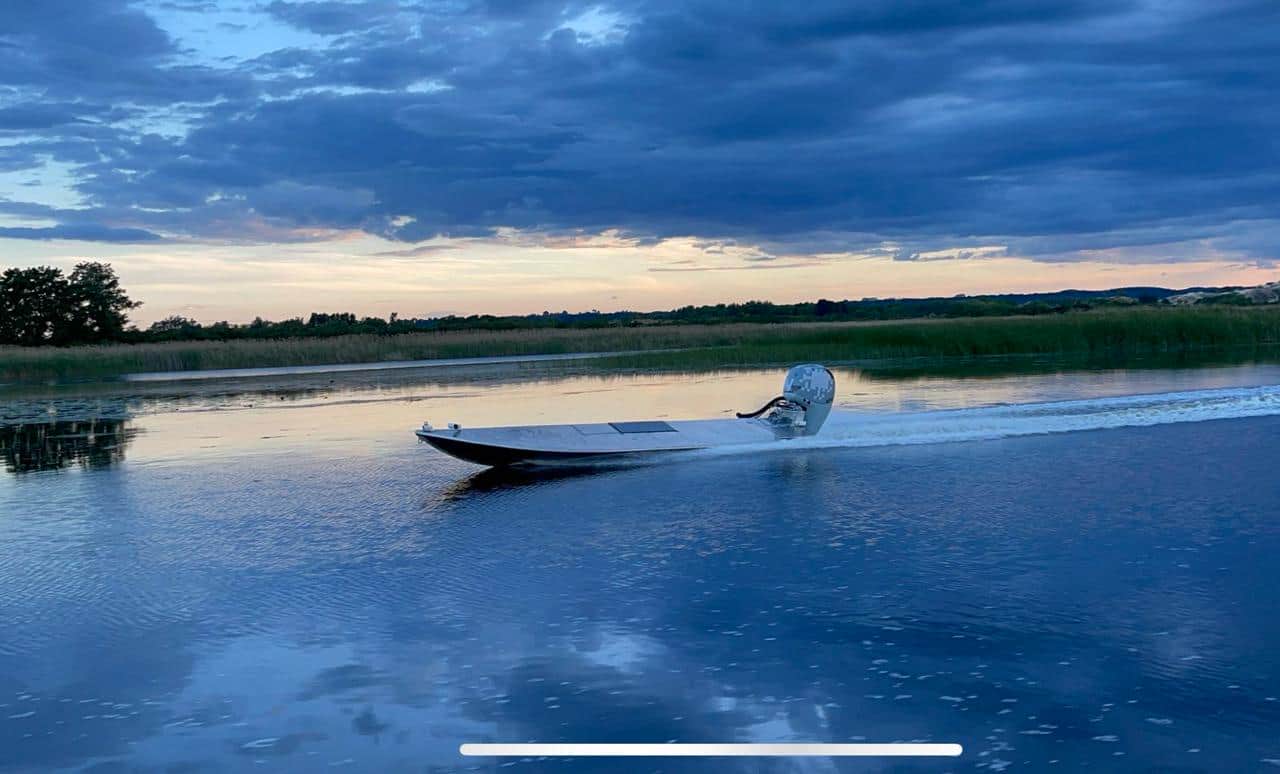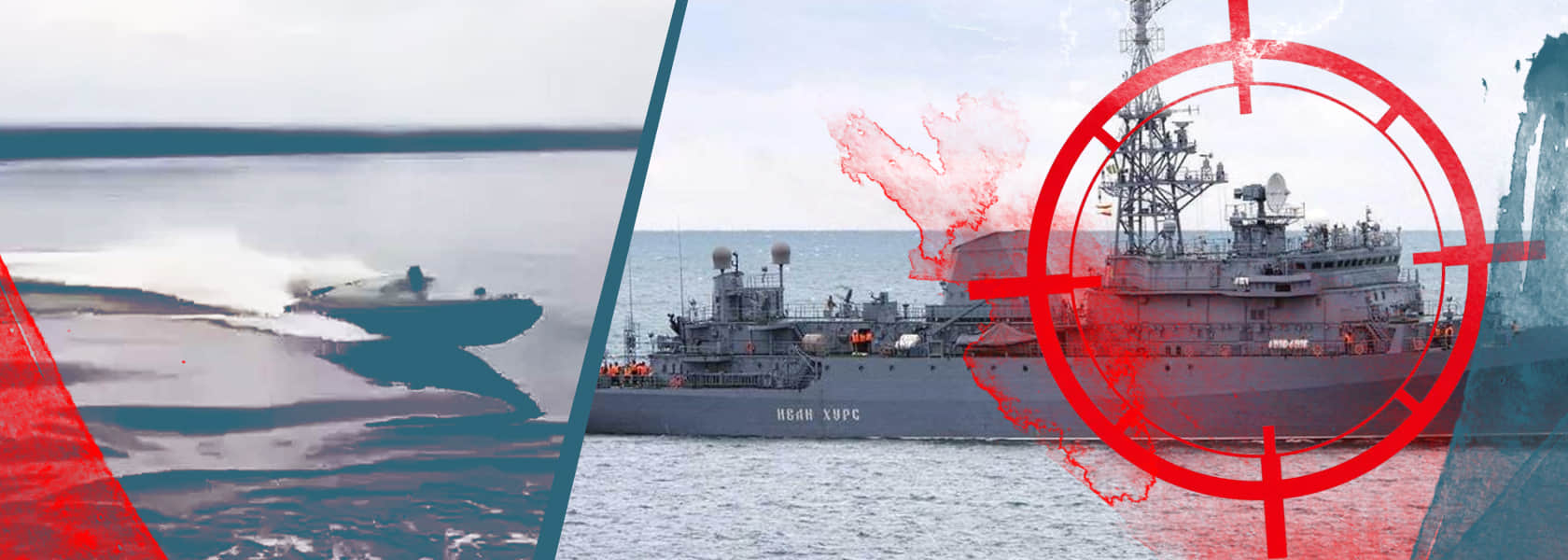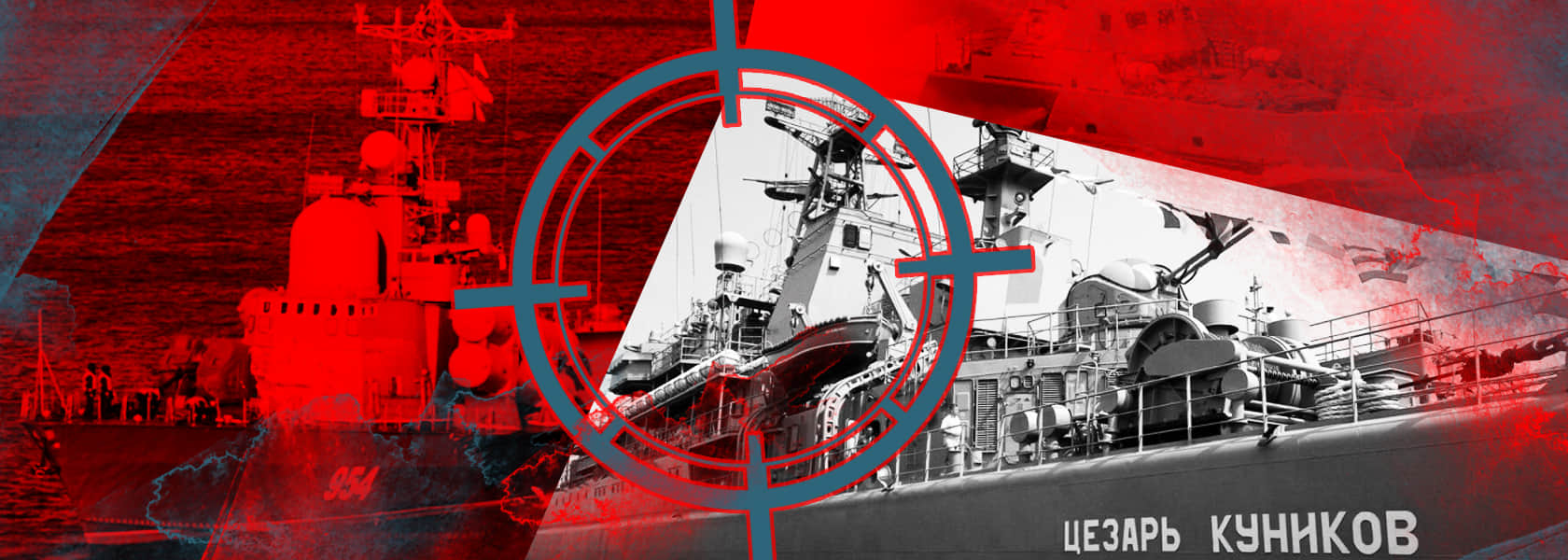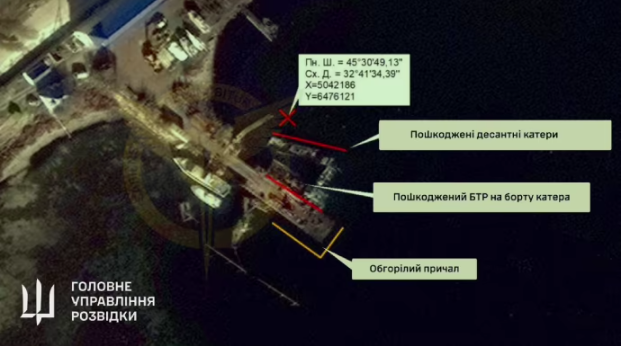Target and eliminate: How Ukraine's Magura drones devastate Russian ships

On 14 February 2024, residents of Russian-occupied Alupka awoke to the sound of explosions. From the sea came the sounds of gunfire and, as the Kremlin might say, cotton (this being an Internet meme stemming from Russian propagandists’ initial refusal to call a spade a spade and use the term "vzryv", meaning "explosion" – instead they called it a "khlopok", a word which can mean either "thunderclap" or "cotton").
Everything happened so close to land that flashes could be seen from the shore through the pre-dawn haze. Yet no matter how hard people stared at the bright lights from afar, they could not discern their source.
None of the people watching so intently could have predicted that a new chapter in the history of naval warfare was being written right before their eyes. A large landing ship had been sunk for the first time by Ukrainian Magura V5 uncrewed surface drones.
Even more dramatic was the fact that the drones targeted the Tsezar Kunikov warship, which had been the target of a previous unsuccessful Ukrainian attack using Tochka-U missiles on 22 March 2022, when it was docked at Berdiansk.
That time, the Armed Forces of Ukraine sank one landing ship, the Saratov, and severely damaged another, the Novocherkassk – yet the Tsezar Kunikov narrowly managed to escape. The ship survived an aerial attack with an old Soviet missile only to fall victim to the latest Ukrainian drones two years later.
The ship's crew returned fire and manoeuvred for a long time to keep the Magura from approaching. The Russians, frantically trying to defend themselves in panic, clearly did not have time to realise what kind of weapon they were being attacked with and respond accordingly.
Nor did the horrified crew of the Tsezar Kunikov have time to fathom that this deadly blow was being inflicted by operators sitting calmly behind a desk at Defence Intelligence (DIU), the Main Intelligence Directorate of Ukraine’s Defence Ministry. The Russians could not possibly have imagined that these operators were in Kyiv, over a thousand kilometres away from the ship, or that a comfortable chair was an essential component of the mission's success.
"The remote bridge itself doesn’t look like anything special. The control interface is small – just two computers and a control panel next to the operator. You also need a table and a comfortable chair. That’s because the operator will be sitting in it for a day or two. Therefore, a chair is needed, but it must be ergonomic and comfortable," explains the head of the unmanned systems department of Ukraine’s Defence Intelligence, a general with the alias "Borets" ("Fighter"), in a conversation with Ukrainska Pravda.
In this story, Ukrainska Pravda explores the establishment of a naval combat department within Ukraine’s Defence Intelligence, the uniqueness of the Magura V5 drone, which allowed Ukraine to start sinking Russian vessels instead of just damaging them, and whether such a system could liberate Russian-occupied Crimea.

Slavic goddess of victory: the story of Magura
The Magura V5 drones almost didn’t end up in the hands of Ukraine’s Defence Intelligence.
The private company that assembles these systems and, for security reasons, prefers not to identify itself in public had previously worked with a completely different power structure – the Security Service of Ukraine (SSU).
A General of Ukraine’s Security Service who goes by the alias "Hunter" once drove to the testing site of Magura’s manufacturer and saw a UAV with a Starlink receiver installed on it. Ukrainska Pravda has already written about this event because it marks the beginning of the story of the Security Service’s Sea Baby surface drones.
When the summer of 2022 rolled around, no Magura or Sea Baby drones had yet been built; they were still ideas on a drawing board. But it wasn’t long before the assembly of the first naval drone prototype had been completed.
It was a fairly simple design, almost primitive in comparison to current models. It had a single Starlink communication channel, a simple engine, and a control system. However, in June 2022, the team launched it on one of the larger reservoirs and began testing its endurance and manoeuvrability.

Everyone liked the idea of naval combat drones, and in early September, a batch of sea drones was ready. On the night of 16-17 September 2022, they were sent on their first mission in the bay of Sevastopol. According to Ukrainska Pravda, this mission failed due to issues with Starlink, which would not work in Crimea thanks to sanctions.
Just over a month later, on the night of 28-29 October, Ukrainian drones managed to break through into Sevastopol, damaging the Black Sea Fleet's new flagship, the Admiral Makarov.
Despite the initial success of these efforts by the developers and the Security Service of Ukraine, disputes arose on a regular basis over the quality of the drones, their specifications, and the project’s budget. So by the end of 2022, the SSU had decided to develop unmanned vehicles on its own.
The company that assembled the first naval drones then signed a new contract with Defence Intelligence.
"We weren’t the first ones they approached, but we saw the potential in their development. So we began to work together and still work together quite successfully," recalls the head of Ukraine’s Defence Intelligence, Kyrylo Budanov, in a conversation with Ukrainska Pravda.
When DIU officials began their meeting with the developers, Ukraine's Defence Intelligence already had a department dedicated to unmanned systems. They had even tried to build their own naval drones.
"We’d been working towards this goal since the summer of 2022. Then we started making drones, specifically naval ones. Initially, they were based on existing watercraft, including jetskis and boats, with remote control systems installed.
The first use of naval drones occurred on our rivers in late July 2022. A small number were used on the Dnipro in Zaporizhzhia Oblast, both for reconnaissance and as kamikaze drones," recalls Borets.
"At expositions around the world, you can find plenty of naval vehicles for a variety of purposes. However, no one had ever created vehicles like these until the start of the full-scale war in Ukraine. We started looking for domestic producers who could do it," he adds.
Borets and Ukraine's Defence Intelligence team visited drone manufacturers' facilities in the autumn of 2022 to see what developments had already been made.
"They hadn’t started production back then. They demonstrated their product's capabilities right on the river. We liked it; everything appeared to be very promising: their implementation of 21st-century technologies was readily apparent," Borets said.
What those early models were capable of can best be summed up by a single anecdotal story told by the engineers.
To demonstrate their drones' manoeuvrability and controllability, they were launched on a large reservoir near Kyiv. The route tracker was the highlight of that voyage: viewed on the map display, the drone had traced out the phrase "Russian warship, go f**k yourself".
"We’d spent about three hours writing that out. And it hadn’t been pre-programmed with directions – it was under manual control. My fingers were sore after it was done," recalls one of the participants in that demonstration.
Ukraine's Defence Intelligence officers liked what they saw, so when the drone company parted ways with the Security Service of Ukraine, they took them under their wing.
Their drone was called Magura, after the goddess of war and victory in Slavic mythology.
Read also: Sea drones, Elon Musk, and high-precision missiles: How Ukraine dominates in the Black Sea

Magura’s first mission with Ukraine’s Defence Intelligence
The transition of the developers to the patronage of Defence Intelligence occurred during the "off-season". The Black Sea has more or less favourable conditions for navigation, and thus drone testing, from late March to early November.
As a result, the Magura team had more time to focus on developing their product. The primary changes involved communication systems. The developers attempted to drop their reliance on Starlink, a task at which they succeeded. In modern versions, almost all communication and management functions are duplicated: when one channel fails, another comes online as a backup.
However, the Magura had to wait several months before experiencing its first success in its new role.
This occurred in May 2023. The Russian spy ship Ivan Khurs was operating 120 kilometres northeast of the Bosphorus Strait.
"The Ivan Khurs was our first successful strike. However, the drone had to sail for over 500 kilometres in an extremely difficult operation. The start of the mission had been delayed due to inclement weather. The connection dropped repeatedly," recalls Borets.
"The connection cut out as we approached the ship, which at that point was nearly a hundred metres away. We couldn't see anything and didn't have control over the drones, so the enemy crew began to repel the attack... The connection was eventually restored, and we followed the ship for six hours, waiting until it ran out of ammunition.
After about two hours, it became clear that the ammo hadn’t run out. We caught up to the ship at half past midnight, and they kept shooting back at us till around 07:00. During the long pursuit, some drones ran out of fuel. Several others sustained damage. But we still managed to reach it," the general explains.
Two months earlier, at the end of July 2023, the Magura would overtake and damage the patrol ship Sergey Kotov at sea for the first time. They would meet for the second time in September 2023, and the Kotov, along with another ship, the Vasily Bykov, would be damaged again but not sunk.
The summer of 2023 was the start of the arms race between different Ukrainian surface drone projects.
By that time, the SSU had already launched its main Sea Baby drone and was working with a private company to use the Mamai high-speed naval drone.
In general, all of these platforms looked similar. However, a closer look reveals that they were designed for different tasks.
The Sea Baby is a multi-purpose platform that can be used for minelaying and striking static targets such as bridges, and even has flamethrower systems on board.
The Mamai is a long-range drone that doesn't carry a lot of explosives, but is capable of hitting large targets at great distances. The Mamai, for example, was used in two successful attacks on Novorossiysk.
The Magura V5 was designed as a pure hunter. As the developers explain, this model was created specifically for hunting warships at sea, so it is smaller, faster, and much more manoeuvrable than other similar drones.
"Everyone built their own thing. We decided to design a drone for hunting down and destroying ships. That was our choice; we worked towards that design brief. Constant patrolling is not for us. Our drone is deployed on an as-needed basis. We designed it specifically to intercept ships," Budanov explains in an interview with Ukrainska Pravda.
"Novorossiysk Bay and Sevastopol are interesting targets. The defences there are comprehensive, but they can be overcome. And why do we need to expend a lot of effort and resources trying to break through harbour defences with a low chance of success when it would be far easier to intercept the ships when they are out on duty or being repositioned?" Budanov adds.
And although all the DIU sources claim that they are cooperating closely with the SSU, the DIU reported that the agencies are actually engaged in fierce competition to see whose drones are better, to the ridiculous extreme of operators from different agencies sitting in the same room refusing to reveal coordinates of targets to each other before a mission. The best results are achieved when the services cooperate rather than compete.
For instance, during the attacks on Novorossiysk, the DIU, SSU and Navy planned the operation together, and eventually the SSU's Mamai drone hit the Olenegorskiy Gornyak large landing ship and the Sig tanker.
And that’s not the end of the story – Magura drones took part in the Novorossiysk operation, but this fact and the participation of the DIU was not even mentioned in the official press releases following the mission.
Needless to say, this only made Budanov's team even more focused on results.

The first sunken ships
The Magura’s time to shine arrived in November 2023.
On the night of 10 November, the DIU’s drones did what they were designed to do for the first time. Off the Crimean coast near the village of Chornomorske, a Magura tracked and targeted two Russian fast landing craft in a convoy: Serna and Akula.

It was in this operation that the Magura’s ship-hunting capabilities were first revealed. The two subsequent missions of these drones only further demonstrated their potential. On 1 February 2024, the guided-missile corvette Ivanovets was blown up, and on 14 February, the large landing ship Tsezar Kunikov went down.
If we count the Serna and Akula, the Magura drone has succeeded in not just damaging but outright sinking four vessels of the Russian Black Sea Fleet in a row.
"Earlier, the number of drones used was smaller and their main task was to simply hit a warship; now they operate in groups of more than five, allowing them to take on different roles and have a specific place in the order of attack, etcetera," a member of the Magura development team explained to Ukrainska Pravda.
"The main goal of the first phase of the attack is to immobilise the target, so the first strike is usually to the engines. In the second phase, the most vulnerable part of the ship, as determined by our intelligence, is hit. If a hole is blown in the hull, additional drones are driven into it and detonated," the manufacturer explains, regarding tactics.
Then the third and final phase is to watch the ship sink.
The Magura drone itself is a very expensive piece of equipment. No one would disclose the exact price, but it is millions of hryvnias per unit. The drone is so expensive that even the head of the DIU, Kyrylo Budanov, who often goes out on missions with his men, has never been tempted to try operating it himself.
"I’ve never operated the drone. First of all it is a dangerous weapon, and a serious piece of equipment that costs quite a lot of our taxpayers’ money. I think everyone should do their [own] job," explains Budanov.
Each drone does cost a substantial amount of money, but it is obvious that they pay dividends in terms of damage done to the enemy’s fleet.
The effectiveness of the new Magura-based sea denial tactic is impressive, something which hasn’t been lost on Moscow, as their Iskander missile strike on one of the production facilities demonstrated. After that, all production moved to underground locations.
But what made it possible to transition from just damaging ships to almost guaranteeing their sinking?
"You see, the technology is developing, and the operators’ skills are growing. I’d like to think that it’s solely a matter of our technological and experiential superiority, but in reality the training of our target ships’ crews, or lack thereof, also plays a role. And yes, luck is also a factor, but fortune favours the prepared," says Budanov.
He also explains that it is important to be able to quickly adapt to changes in the situation and decide where to go during the operation.
"The most important thing here is to not interfere with the operators' ability to act according to the plan. And when something goes wrong, we need to make quick decisions about what to do next and how to do it. For example, the Tsezar Kunikov was not our primary target initially. But the chances of hitting our original target decreased during the mission itself," explains Borets.
He said that the Maguras were hunting a convoy, but just a few hours before the drones' approach, the ships started moving, making it no longer possible to hit the main target.
***
Everyone Ukrainska Pravda spoke to at the DIU and among Magura's engineers claim that the drone has not yet reached its full potential.
The next step is to equip the drones with air defence systems and possibly other weapons.
"Experts are currently working on installing air defence equipment on the unmanned platform. I'm not a technician, but I understand that this is a rather difficult task. You need equipment to detect a target, capture an airborne object, and destroy it – all on a fairly small platform. It's not an easy task technically, but it is possible," Budanov says.
One of the developers explains that wave impacts and rocking motions put such a strain on the drone's structure that it would be a herculean task to develop a stabiliser capable of compensating for such motions. And without a stable platform, no weapon system will work, because it simply won't be able to aim and fire.
But this work is already underway, and very soon the drones will be able to carry various modules to hit all types of targets: ground, surface, and air. And the drones themselves will be made less and less noticeable, up to and including the ability to dive underwater for a while.
However, no matter how successful Maguras or other UAVs become, they are not capable of conquering territory, only eliminating troops and equipment, as General Budanov sums up.
"We must understand that Crimea cannot be reconquered with naval drones. They are only a means to speed up the withdrawal of the Russian Black Sea Fleet from the temporarily occupied Autonomous Republic of Crimea.
They cannot liberate a single millimetre of land. This is a boon, but not a panacea. Just like in the old days, only a man planting a flag on the territory can achieve that goal."
Roman Romaniuk, Ukrainska Pravda